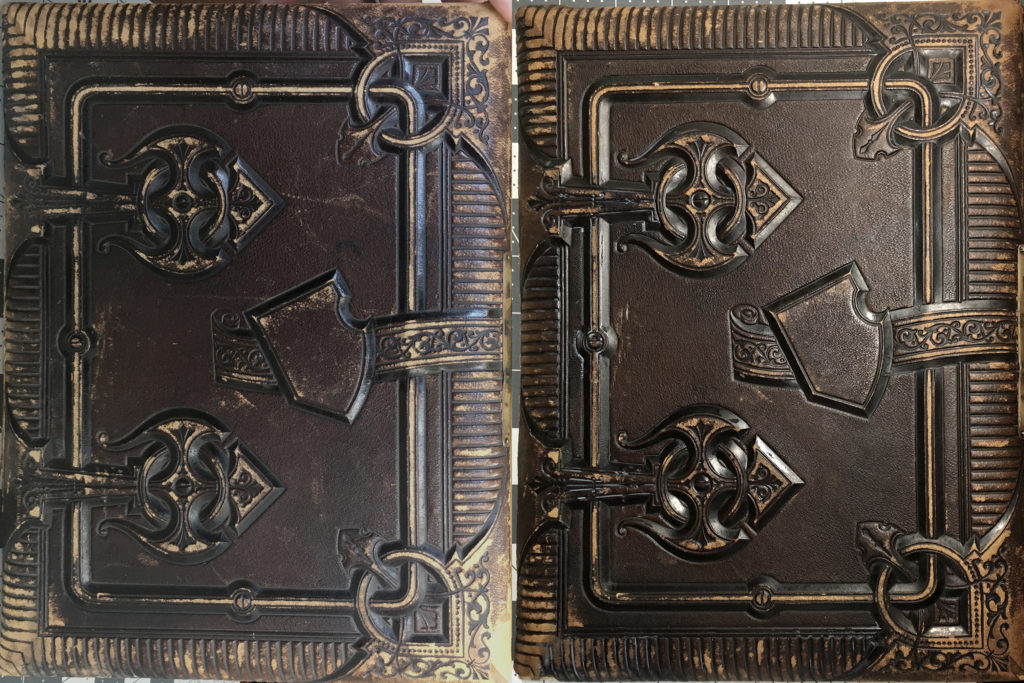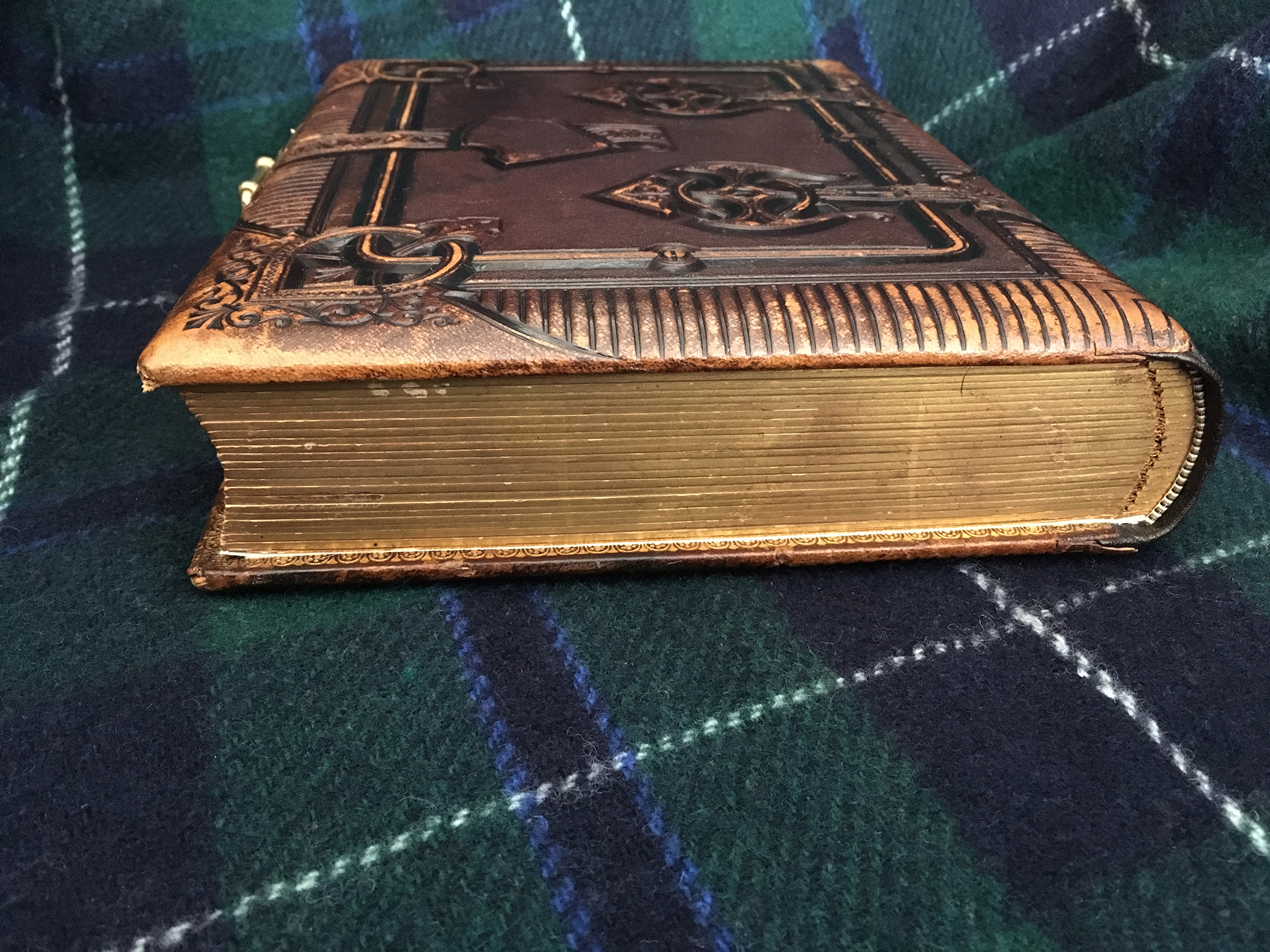A client brought me her family photo album in need of repair. It had sat on a shelf for a long time, and was subject to all environmental contaminants as well as that of pets.
It didn’t need to be rebound, but desperately needed cleaning, leather treatment, new endpapers and a new spine. The following are the before/after images, and a small video of some of the work.





Written by Claudia Swain
We all have a box of books, documents, photographs, maps – Great Aunt Susan or your mom told you to take them and keep them safe and so you did; but you’ve noticed lately the pages are curling, the photographs are yellowing, and the binding is falling apart! Should you get them restored? Obviously we think so, but just in case you need a little inspiration to take that last step, here are the top five reasons you should have your papers and books preserved in 2020.
5. Marie Kondo would be proud of you
Everyone’s favorite tidying-up guru tells us to transform our lives by “choosing joy” by de-cluttering our space and transforming our lives. She dedicates two entire steps to paper and sentimental items- so what do you do with your papers that are deeply sentimental? That family bible in the back of your closet from 1900, the immigration papers of your great-great uncle coming through Ellis Island, Gramps’ love letters to Grandma from during the war – they’ve been sitting in the back of your closet, the bottom drawer of your desk, or somewhere upstate in a non-climate controlled storage unit.
You’ve already decided these items spark joy in your life (and if you haven’t yet, keep reading!) but the next step is preserving and digitizing them. Make sure these items will last a lifetime and will be able to be enjoyed by your children- speaking of which…

4. Your kids need the connection
Scientists have documented what many of us already knew in our hearts: learning about family history benefits children. A big part of growing up is finding our place in the world and learning where we fit in; engaging directly with the relics of our past can really help anchor an adolescent’s identity and help develop a strong sense of place. Kids are shown to have higher self-esteem when they can see themselves as the latest link in a long and storied chain, and there’s no better way to teach them then by allowing them to touch and handle our most precious papers. Grandmother’s high school year book (she was on the swim team! In 1947!!) can be a source of inspiration for even the most difficult teenager after you get it restored.
3. You watch a lot of Antiques Roadshow
Look, we’ve all been there. The student loans pile up; the mortgage is due; you need a little extra cash. Maybe you’ve made it this far and the sentimental reasons weren’t adding up – or paying the grocery bills – and that’s okay! The secret desire that something in the attic is worth a bundle of money is universal. And it’s technically possible but you’ll never know unless you get it restored and appraised!
We admit this is a very long-shot, but dream for a few moments about these real-life examples of striking it rich: this Declaration of Independence was found in a cardboard box outside of Houston and sold for seven figures, another Declaration of Independence was found in a $4 frame in Pennsylvania and sold at auction for one million, a 1774 newspaper was found in a New Jersey Goodwill worth as much as $18,000, and even a 16th century map of America (one of five in the world!) was discovered in Germany stuck between the pages of a book.
2. To learn the hot gossip on your ancestors
Now that we’ve had our dreams, let’s talk about what we wanted to know the whole time- what our ancestors were REALLY getting up to. Now that DNA kits are all the rage, skeletons are letting themselves out of the closet and dancing around the family den. But if you have concerns about giving your genetic material to a private company (and who doesn’t) then finally taking care of your deteriorating family documents is the best move for 2020.

Take my own family’s example. My great-great grandfather William Jesse Wheldon is the only family member to have his death recorded twice in the family bible – due to a miscommunication involving a literal shot through the heart, the Civil War, and tragically spotty postal service, I might never have discovered the story if not for those two lines in the old family tome! Click HERE to read more about our work preserving a similar family bible and see how these precious relics can be preserved for enjoyment for years to come.
1. Because we are what we leave behind
Let’s face it, our days on this earth are numbered. Our descendants will only have the treasures and documents we leave behind, which is how we ended up with these letters, maps, and photo albums in the first place, right? Someone in our past believed that they were worth passing on, and here we are with this legacy. It’s our responsibility to shepherd that legacy to the next generation.
This year is the best time to think about preserving your heirlooms; digital technology has revolutionized how we repair and store relics. Documents even 300 years old can be reconstructed from fragments and stabilized; photographs can be enhanced and optimized with technology for better viewing and sharing; whole collections can be digitized and shared with every member of a far-flung family. Start the new year off right by delving into your own family history and making sure your memories can last to be enjoyed by future descendants decades in the future.
This is a client’s piece, only recently discovered after languishing decades in a trunk in the attic. Working with the client, we agreed on rebinding the book, limited conservation intervention, and as much repair as I could manage.

The clasps were missing from the back, but they remained on front cover. The iron nails holding them in place had rusted and the corrosion damaged some of the brass.

The gilding was really dirty, and was the primary reason why I had the bible in my possession for so long. It took months of trial and error to find a cleaning method that didn’t lift the gold. Some kind of protective cover had been applied to the gold and had gotten dirty and trapped 119 years of grime in place. I tried (in order): water, isopropyl alcohol, leather detergent, soap and water, metal de-corroder, and Brasso; none of which were successful. I consulted a professional gilding studio with over 40 years experience working with gold gilding, and they were stumped, because gold shouldn’t tarnish! I’d already tried all of their suggested fixes, and spent months trying to research a solution- all to no avail.
Ultimately, I found the solution in the book The Restoration of Leather Bindings by Bernard C. Middleton, 4th Ed. Discussing cleaning the leather binding, the entry says “When all else fails, Vulpex, a liquid oleate soap will often work wonders in cleaning grimy gold tooling. A 10% solution in water may be strong enough to brighten dull gold when ordinary soap achieves nothing. In the case of gold tooling which almost looks like blind tooling a 25% or stronger solution may be required… But care should be exercised if the leather is colored because the soap may shift it.”
Vulpex is a soap I use when washing paper- I never considered trying to clean gilding with it, as it is pretty intense stuff, able to clean grease and dirt from paper without any agitation or physical interaction. I had the cleaning agent in my cupboard the entire time! I ended up using a 20% solution and finally seeing what the lovely gold was supposed to look like!

The leather on the covers had been quite worn, and where it rubbed against other books or shelves, the leather dye had been worn away/faded. To fix this, I mixed up a solution of watered-down black watercolor paint, and put a few coats over both front and back, darkening the leather. I didn’t want to use 100% opaque black, because we didn’t want the bible to look completely new; the watered down solution darkened the leather enough to give the design the dramatic contrast it was meant to have, but not completely darkening the leather.

The bible came to me in pieces, and with no spine. I completely re-bound the book by hand, trimming up the edges, cleaning, and mending all the tears and filling in gaps.

This paper was (and mostly still is) highly acidic, which has caused the worst damage to the edges of the paper. The client and I worked to find a good solution on the conservation work to fit their budget, and so I only deacidified the pages that contained handwritten data. The rest of the book remains subject to further deterioration, but I trimmed the edges and reinforced weak points with acid free asian papers, to help the bible last as long as possible. I neglected to get an after photo though!

The paper in the beginning and end of the bible had completely come unbound and had been mixed together. Unfortunately the printers who put the book together didn’t seem to have the process figured out, because each new section (index, Animals of the Bible, etc.) started with page number one- so putting it back in order was particularly challenging, especially the sections that were missing a page or two. I did some research and found a completely digitized version of this bible, and was able to reassemble the book thanks to this reference!

In old books, and especially in large books a binder finds many interesting things; hair, bugs, dirt, seeds, death certificates, old greeting cards, and… Bees? Oh, Bs. It was especially funny to run across these in the binding! Purple bees and their pollen.

This is the hand-binding section. Up to this point in my career, this is the largest book I’ve ever had to re-bind by hand. I think the total amount of time sewing each signature into the book totaled approximately four full days of labor, and this book’s spine was over nine inches wide.

Sadly, the leather had really taken a beating over the years, and had come unglued from the formed cardboard cover- but hadn’t come completely unglued. Only certain parts had come unglued, and I had to come up with a good solution for delivering the glue to the right place, without pulling the whole cover off and risking further damage to the leather. I sent out a query to friends and family, asking how I might get some hypodermic needles- to some predictably wary responses! Thankfully, several friends stepped forward to donate old pet medication needles and unneeded insulin needles to a good cause. This ended up being the best solution to deliver adhesive to the hard-to-reach places.


And here is the finished product! I learned so much from this project, and it was extremely satisfying to bring to completion. My client is happy; I am happy; this book will last many more years to chronicle the life of its family.






















